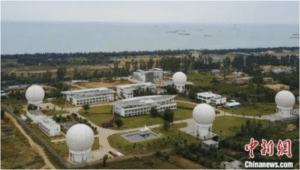by Blaine Curcio and Jean Deville
 As part of the partnership between SpaceWatch.Global and Orbital Gateway Consulting we have been granted permission to publish selected articles and texts. We are pleased to present “Dongfang Hour China Aerospace News Roundup 12 – 18 July”.
As part of the partnership between SpaceWatch.Global and Orbital Gateway Consulting we have been granted permission to publish selected articles and texts. We are pleased to present “Dongfang Hour China Aerospace News Roundup 12 – 18 July”.
Hello and welcome to another episode of the Dongfang Hour China Aero/Space News Roundup! A special shout-out to our friends at GoTaikonauts!, and at SpaceWatch.Global, both excellent sources of space industry news. In particular, we suggest checking out GoTaikonauts! long-form China reporting, as well as the Space Cafe series from SpaceWatch.Global. Without further ado, the news update from the week of 12 – 18 July 2021.
1) Additional Spaceplane Activity from China
Jean’s Take
China successfully completed the launch and flight of a suborbital spaceplane on July 16th. Not much else is known, and the Chinese press release was very short, but observers seem to be hinting at a prototype for a VTHL first stage spaceplane, which could typically have a second stage attached to it.
This could look like a similar configuration to the Darpa/Boeing XS-1, which had adopted a similar launch architecture, but was unfortunately cancelled in 2020.
And back to China, this architecture would make sense as it seems to match with the step 1 on the spaceplane roadmap presented by Long Lehao, the chief engineer of the Long March rockets at CALT, at Hong Kong University a couple of weeks ago. Step 1 seems to be a VTHL first stage, using traditional rocket engines, and carrying what looks to be a classical second stage. Step two would be spaceplane second stage (meaning that the second stage would be able to land horizontally), and step three would be a single-stage-to-orbit combined cycle engine spaceplane. This 3rd step would definitely be something, an unprecedented technical achievement.
Another noteworthy takeaway from this piece of news is China’s persistence with developing spaceplane technology as a solution for reusable spacecraft. With SpaceX having demonstrated that VTVL can be extremely cost-efficient while being technically more simple, many commercial spaceplane projects have been dropped, and Boeing dropped out of the XS-1 project probably for this reason.
Maybe a reason that could explain China’s persistence is if there was a non-commercial use for such a spaceplane, which could explain all the secrecy surrounding the launch. In the US for example, the US Air Force has been operating the X-37B, which is a different kind of spaceplane but a spaceplane nonetheless.
Worth noting also, a different spaceplane was launched by China on September 2020. Not much is known here either, other than the fact that it was launched on-board a Long March 2F, and landed horizontally.
We had also reported a couple of weeks ago on China performing tests for engine precooling technology, which is a key milestone for combined cycle engines used on a full-fledged spaceplane.
2) China Hands Out First Lunar Samples to Research Institutes
Jean’s Take
The Chinese National Space Administration (CNSA) held a ceremony on July 12 for the first distribution of lunar samples to research institutes. The lunar samples were part of the 1.731 kg collected by the Chang’e 5 mission at the end 2020, and returned to Earth in January 2021.
For this first attribution of samples, a total 17.4764 g were lent to 31 applications from 13 research institutes, so a mere 1% of the precious samples. Apparently this was out of a total of 85 applications, so barely 36.5% of them passed the acceptance review. Applications had to hold “important scientific significance”, and it was also evaluated if the “research plan was feasible and whether the applicant had relevant research capabilities”.
We also know that the CNSA had initially prepared 44 lunar samples in April (for a total weight of 56.8812 g), so it seems likely that many such loans will take place in the future, the next one being in September.
It’s also amusing to note that the samples are given with a precision of a ten thousandth of a gram, showing just how precious these samples are. But then, if we consider as a thought exercise that the Chang’e 5 mission cost several billion RMB (say 4 billion), that means that each gram is worth over 2 million RMB (!!), which makes going down to the smaller digits much easier to comprehend.
The happy few to get some samples were:
- Beijing Research Institute of Uranium Geology (核工业北京地质研究院)
- Chinese Academy of Space Technology (中国空间技术研究院)
- Institute of Geology of the Chinese Academy of Geological Sciences (中国地质科学院地质研究所)
- China University of Geosciences in Beijing(中国地质大学)
- China University of Geosciences in Wuhan(中国地质大学)
- USTC in Hefei (中国科学技术大学)
- Sun Yat-Sen University in Guangzhou (中山大学)
- CAS Institute of Geochemistry, in Guiyang (中国科学院地球化学研究所)
- CAS Institute of Geology and Geophysics (中国科学院地质与地球物理研究所)
- CAS Guangzhou Institute of Geochemistry (中国科学院广州地球化学研究所)
- CAS NSSC (国家空间科学中心)
- CAS Nanjing Institute of Geology and Paleontology (中国科学院南京地质古生物研究所)
- CAS Purple Mountain Observatory (中科院紫金山天文台)
It’s interesting to note that you have some of the big names of China’s space research laboratories (CAST, NSCC, Purple Mountain Observatory, USTC maybe), but otherwise we are looking mainly at Geosciences institutes (8 out of 13).
Worth noting also, the seemingly highly specialized Institute of Uranium Geology, which could hint at research on the presence of H3, a highly prized component for nuclear fusion.
Interestingly, foreign research institutes were allowed to apply for samples as well, although no formal foreign application was received according to Pei Zhaoyu, deputy director of the CNSA’s Lunar Exploration and Space Engineering Center and director of the Lunar Sample Management Office.
Blaine’s Take
Indeed, very important to measure out that last 0.0004g. And, would have been quite a shame if CAST was denied the samples given the role they played in getting the samples back to earth.
Not a whole lot to add from my side, but a few points worth mentioning: first, incredible that the particles of lunar soil are so fine that there are concerns about the particle becoming charged by a tool handling it, leading to some loss of sample. As such, Deputy Designer of the Third Phase of the Lunar Program and Chief Designer of the Ground Systems Li Chunlai mentioned that they are trying to minimize the amount of direct contact between tools and the samples. We also saw during the press conference a reference to the Wolf Amendment, passed by the US Congress in 2011 and largely prohibiting NASA from cooperating with the CNSA or any other Chinese actors. Director of the Lunar Sample Expert Committee and Academician of the CAS Zhu Rixiang noted that because of the Wolf Amendment, China’s lunar research was delayed/restricted, but that now they are able to do it themselves (由于美国的沃尔夫法案,中国科学家基本拿不到阿波罗月球样品进行研究,制约了我们国家月球与行星科学的发展。现在我们可以培养自己的研究队伍了).
3) Deep Blue Aerospace completes 10-second static fire test of the Nebula-M Engine
Jean’s Take
Two weeks ago, we had predicted that Deep Blue Aerospace was very close to static fire tests (based on their social media posts). And indeed on 13 July, Deep Blue Aerospace (DBA) announced the completion of a first static fire test of the company’s Nebula-M prototype rocket.
The Nebula-M, as mentioned 2 weeks ago, is a very small single stage rocket, whose sole purpose is to help DBA develop VTVL technology (since DBA liquid-fueled rocket the Nebula 2 plans to be reusable from day 1).
According to DBA’s news release, the test lasted barely 10 seconds, and aimed at testing the coordination between the Leiting-5 kerolox engine and the other systems on-board. The data retrieved showed apparently that all systems were nominal (notably engines, hydraulic, electrical, telemetry and control systems). Coming up next should be a much longer, variable thrust, static fire test.
Blaine’s Take
Noteworthily, the test was apparently carried out at the Tongchuan Commercial Space Base (铜川商业航天基地) in Tongchuan, Shaanxi Province, because why not have a Commercial Space Base in a city of like 900,000 people.
4) Tencent Launches Space Program
Blaine’s Take
During 2021 World AI Conference in Shanghai on July 8th, Tencent, through its CEO Pony Ma, announced that it would launch a “Star Exploration Program” (探月计划) in collaboration with the
National Astronomical Observatories of China (NAOC), a branch of CAS and managing most (but not all) of China’s observatories. This includes a large number of optical and radio telescopes, such as the massive 500m aperture radio telescope in Guizhou called FAST, and the largest such telescope in the world.
Astronomy is one of the very data-intensive branches of space sciences, where AI, computer power, and Cloud computing make absolute sense. Imagine the dozens and dozens of professional telescopes, continuously pointing at different areas of the sky and collecting TB and TB of data, and that all need specific processing. Tencent, as one of China’s leading tech firms, is clearly in a position to play a role here.
The timing is interesting, as many Chinese tech companies are facing regulatory crackdowns, Tencent among them. Moving into a rather sensitive area like space is therefore a pretty bold move, in particular doing so via an announcement from the company CEO, who is known to be quite a bit more low-profile than some of his peers. During Ma’s speech, which was delivered via a Wechat for Business voice message and lasted a whopping 145 seconds, he highlighted the importance of AI in improving people’s lives, and highlighted Tencent’s emphasis on “sustainable AI innovation”.
Last point to note on the World AI Conference and Chinese tech–Robin Li, CEO of Baidu, also gave a speech (in person), during which he mentioned the importance of AI and computing for the Zhurong Rover, and made a connection between the tech involved with Zhurong and the tech required for autonomous vehicles.
Jean’s Take
Tencent’s strong skills in AI and Cloud will definitely benefit the NAOC. I’m not sure what’s in it for Tencent, but considering the amount of data to be processed and the size of the NAOC, this deal represents at the very least a very nice additional big customer to Tencent AI/Cloud services, as well as a good PR event.
As an amateur astrophotographer myself who uses quite a bit of software and computer processing (also shameless plug for my astrophotography Instagram that I will put up here on the episode/show notes), I can definitely only rejoice at the idea of such a partnership around astronomy and AI.
5) Hainan Province Publishes “14th Five-Year Plan for the Development of Hainan High-tech Industries”, with Strong Emphasis on Space
Blaine’s Take
On July 7th, Hainan Province officially unveiled the “14th Five-Year Plan for the Development of Hainan High-tech Industries”, which shed light on China’s southernmost province’s strategy for the next five years. Of particular interest was the focus on the space industry, which was quoted to be one of Hainan’s “three future industries” (alongside smart agriculture and marine engineering). In an interview to the Hainan Daily, head of the provincial department of industry and information technology (MIIT) Yin Libo mentions that the plan “promotes the development of rocket research and development, commercial satellite research, satellite navigation and other industries, and builds aerospace high-end product R&D and manufacturing bases and “aerospace +” industrial demonstration zones.” Overall, the plan aims to lead to a space sector in Hainan of more than RMB 10B by 2025.
 One of the cornerstones of this strategy will be the development of Wenchang International Aerospace City (located on the North eastern coast of Hainan), which already hosts China’s new generation launch center (for launches of Long March 5-8). The Province plans to attract and concentrate space firms in the area, covering design, manufacturing and operations, and specifically noting plans for deepening cooperation with the CAS, CASC, and others. This closely resembles strategies undertaken by other provinces to develop the local space industry (and just high-tech industries in general), with varying levels of success.
One of the cornerstones of this strategy will be the development of Wenchang International Aerospace City (located on the North eastern coast of Hainan), which already hosts China’s new generation launch center (for launches of Long March 5-8). The Province plans to attract and concentrate space firms in the area, covering design, manufacturing and operations, and specifically noting plans for deepening cooperation with the CAS, CASC, and others. This closely resembles strategies undertaken by other provinces to develop the local space industry (and just high-tech industries in general), with varying levels of success.
That being said, Hainan is in a different position than any other Chinese province, in terms of economy and geography. First, the island province has, by a wide margin, China’s most famous coconut milk. For anyone who has been to a Chinese supermarket, the ubiquitous thin black cans with yellow font can only mean one thing–海南椰树牌 (Hǎinán yē shù pái), or the local coconut milk, available on Amazon for about $27 per 24-pack. Also noteworthy is the fact that the best dim sum I have had in my life, ever, was in Haikou in 2019.
On a more serious note, From an economic perspective, in mid-2020, the Central Government announced plans for the Hainan Free Trade Port (FTP, 海南自由贸易港), which aims to transform Hainan Island into a globally significant FTP by 2050. The announcement was aimed at spurring development in what has historically been a less-developed part of China, while also allowing for a certain degree of economic experimentation in a confined environment (more on that momentarily).
 The FTP-related incentives include simplifying customs processes, allowing for tariff exemptions on imported goods if over 30% of the value-added processing is done in the FTP, and providing greater regulatory support. These macro-level policies, combined with specific space-related policies emphasized by Hainan, mean that we could see a significant space cluster built there in the coming years.
The FTP-related incentives include simplifying customs processes, allowing for tariff exemptions on imported goods if over 30% of the value-added processing is done in the FTP, and providing greater regulatory support. These macro-level policies, combined with specific space-related policies emphasized by Hainan, mean that we could see a significant space cluster built there in the coming years.
Separate from its economy, Hainan is geographically unusual among Chinese provinces in that it is an island, which provides advantages and disadvantages. On the plus side, by virtue of being an island, Hainan lends itself to more economic experimentation. It’s easier to control the borders between Hainan and the rest of China than it would be to control the borders between, for example, Guangdong and the rest of China. Its location relatively near the equator is also an advantage for launches.
Being an island also comes with disadvantages, however. The infrastructure on Hainan is much less-developed than many parts of China, with this including telecoms, power generation, and public transport. Moving forward, it’s possible that huge investment by the Government of Hainan into infrastructure, combined with incentives for talents (of which there are many) can contribute to a virtuous cycle of talents coming to the island, the island seeing more economic development and being able to invest more into infrastructure, making it more attractive for talents to come to Hainan, and so on.
 Back to the interview with Yin Libo, it’s noteworthy that despite all the different space initiatives he mentioned, absent was the space industry cluster in Sanya, in Hainan’s southwest corner. Sanya’s space cluster is predominantly focused on Earth Observation (EO), and has close relations with the Chinese Academy of Sciences (CAS), which has a facility in Sanya. The massive Sanya facility (shown at right) recently celebrated its 10th anniversary, during which time its data throughput has increased by >7x.
Back to the interview with Yin Libo, it’s noteworthy that despite all the different space initiatives he mentioned, absent was the space industry cluster in Sanya, in Hainan’s southwest corner. Sanya’s space cluster is predominantly focused on Earth Observation (EO), and has close relations with the Chinese Academy of Sciences (CAS), which has a facility in Sanya. The massive Sanya facility (shown at right) recently celebrated its 10th anniversary, during which time its data throughput has increased by >7x.
Moving forward, we can’t know for sure whether the space-related developments on Hainan will be a success, but we can be fairly sure that the island will remain a home to reasonably-priced coconut milk and dim sum.
This has been another episode of the Dongfang Hour China Aero/Space News Roundup. If you’ve made it this far, we thank you for your kind attention, and look forward to seeing you next time! Until then, don’t forget to follow us on YouTube, Twitter, or LinkedIn, or your local podcast source.
Blaine Curcio has spent the past 10 years at the intersection of China and the space sector. Blaine has spent most of the past decade in China, including Hong Kong, Shenzhen, and Beijing, working as a consultant and analyst covering the space/satcom sector for companies including Euroconsult and Orbital Gateway Consulting. When not talking about China space, Blaine can be found reading about economics/finance, exploring cities, and taking photos.
Jean Deville is a graduate from ISAE, where he studied aerospace engineering and specialized in fluid dynamics. A long-time aerospace enthusiast and China watcher, Jean was previously based in Toulouse and Shenzhen, and is currently working in the aviation industry between Paris and Shanghai. He also writes on a regular basis in the China Aerospace Blog. Hobbies include hiking, astrophotography, plane spotting, as well as a soft spot for Hakka food and (some) Ningxia wines.
 SpaceWatch.Global An independent perspective on space
SpaceWatch.Global An independent perspective on space




